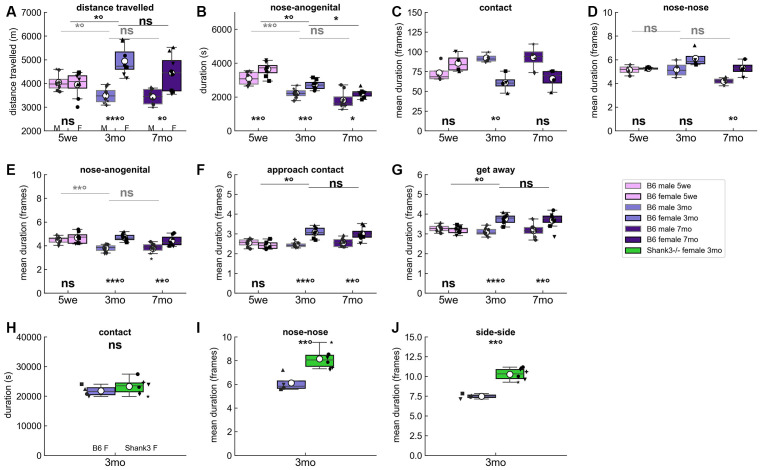Figure 2.
Spontaneous behaviors in B6 male and female pairs as well as in Shank3−/− female pairs over three nights. (A) Total distance traveled over the three nights of recording in B6 male (M) and female (F) pairs at the three age classes tested. Age- and sex-related variations in the (B) total time spent in nose-anogenital contact, (C) mean duration of contact events (i.e., contacts in a broad sense without any specific body part involved), (D) mean duration of nose-nose contact events, (E) mean duration of nose-anogenital contact events, (F) mean duration of social approach events, and (G) mean duration of get away events over the three nights of recording. Each black dot corresponds to an individual in (A,B,E–G) with a similar shape for the two individuals of the pair, while in (C,D) each dot corresponds to a pair since the behaviors are symmetrical (Mann–Whitney U-tests used to test for differences between sexes within each age class; Kruskal–Wallis test followed by Wilcoxon paired test if significant to test for differences between 5 weeks and 3 months and between 3 months and 7 months within each sex). Comparisons between B6 female pairs aged 3 months and age-matched Shank3−/− female pairs of the (H) total time spent in contact, (I) mean duration of nose-nose contact events, and (J) mean duration of side-side contact events over the three nights. Each black dot corresponds to a pair since the behaviors are symmetrical (Mann–Whitney U-tests used to test for differences between genotypes). Uncorrected p-values: ns: non significant, *p < 0.05, **p < 0.01, ***p < 0.001. P-values followed by ° survived a correction for multiple testing over age classes.

